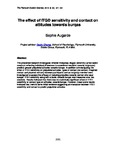The effect of ITGD sensitivity and contact on attitudes towards burqas
| dc.contributor.author | Augarde, S. | |
| dc.date.accessioned | 2019-05-15T13:24:27Z | |
| dc.date.available | 2019-05-15T13:24:27Z | |
| dc.date.issued | 2012 | |
| dc.identifier.citation |
Augarde, S. (2012) 'The effect of ITGD sensitivity and contact on attitudes towards burqas', The Plymouth Student Scientist, 5(2), p. 121-144. | en_US |
| dc.identifier.issn | 1754-2383 | |
| dc.identifier.uri | http://hdl.handle.net/10026.1/13987 | |
| dc.description.abstract |
The presented research investigates whether intergroup disgust sensitivity (affect-laden construct reflecting individual differences to experience revulsion towards outgroups) predicts greater prejudicial attitudes towards burqas. In addition to investigating the effect of ITGD sensitivity on prejudicial attitudes, types of contact (no contact, imagined contact and physical contact) between participants and an outgroup member were investigated to assess the efficacy of reducing prejudice towards women who wear burqas. ITGD sensitivity along with attitude towards burqas was measured over two sessions. Results indicated that there was no statistically significant effect of ITGD sensitivity or contact type on attitudes towards burqas. However, mean score results indicated that there is some initial evidence suggesting an interaction between ITGD sensitivity and contact to predict prejudicial attitudes. | en_US |
| dc.language.iso | en | en_US |
| dc.publisher | University of Plymouth | |
| dc.rights | Attribution 3.0 United States | * |
| dc.rights.uri | http://creativecommons.org/licenses/by/3.0/us/ | * |
| dc.subject | ITGD | en_US |
| dc.subject | sensitivity | en_US |
| dc.subject | prejudicial attitudes | en_US |
| dc.subject | imagined contact | en_US |
| dc.subject | physical contact | en_US |
| dc.subject | prejudice | en_US |
| dc.title | The effect of ITGD sensitivity and contact on attitudes towards burqas | en_US |
| dc.type | Article | |
| plymouth.issue | 2 | |
| plymouth.volume | 5 | |
| plymouth.journal | The Plymouth Student Scientist |



